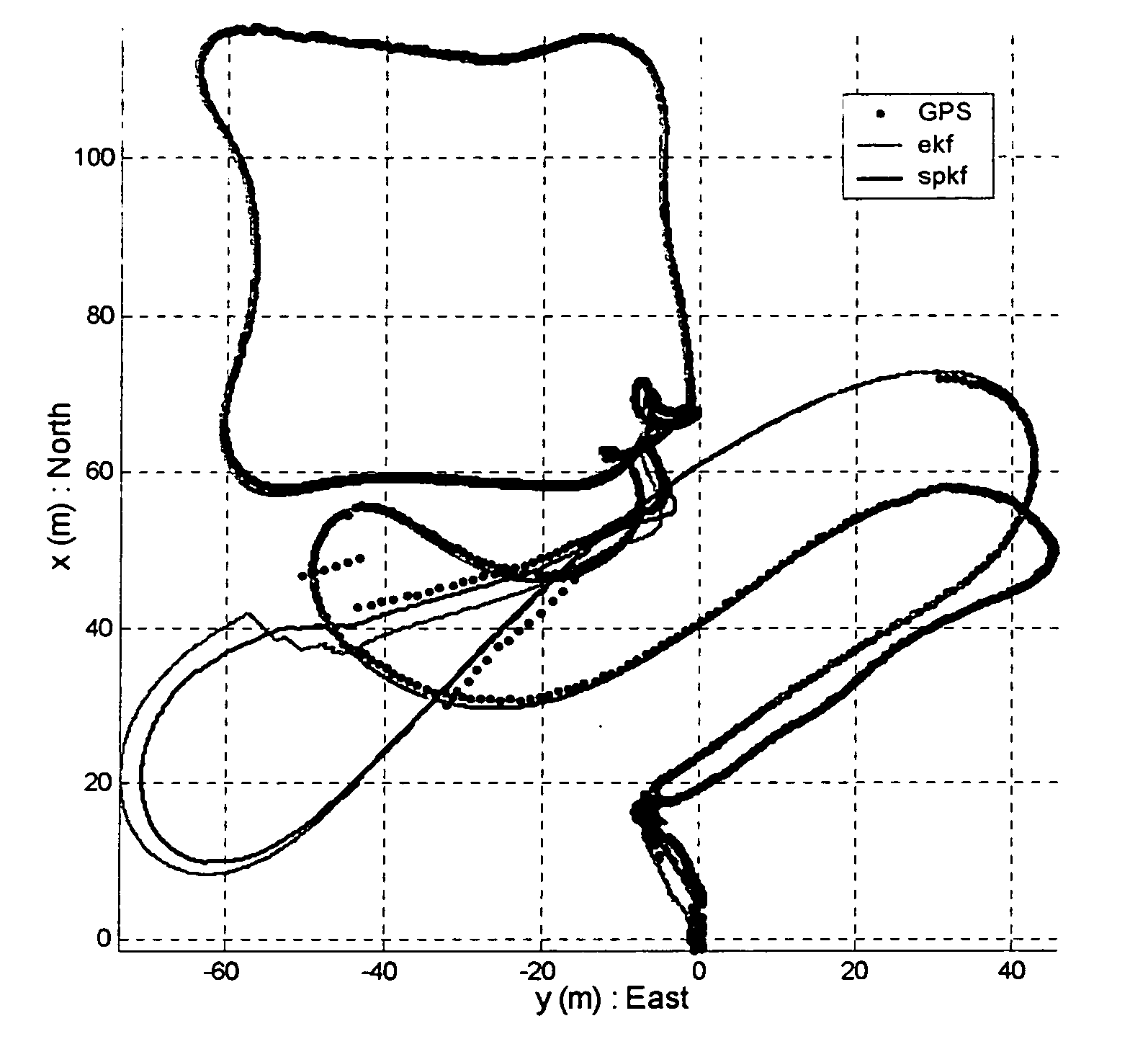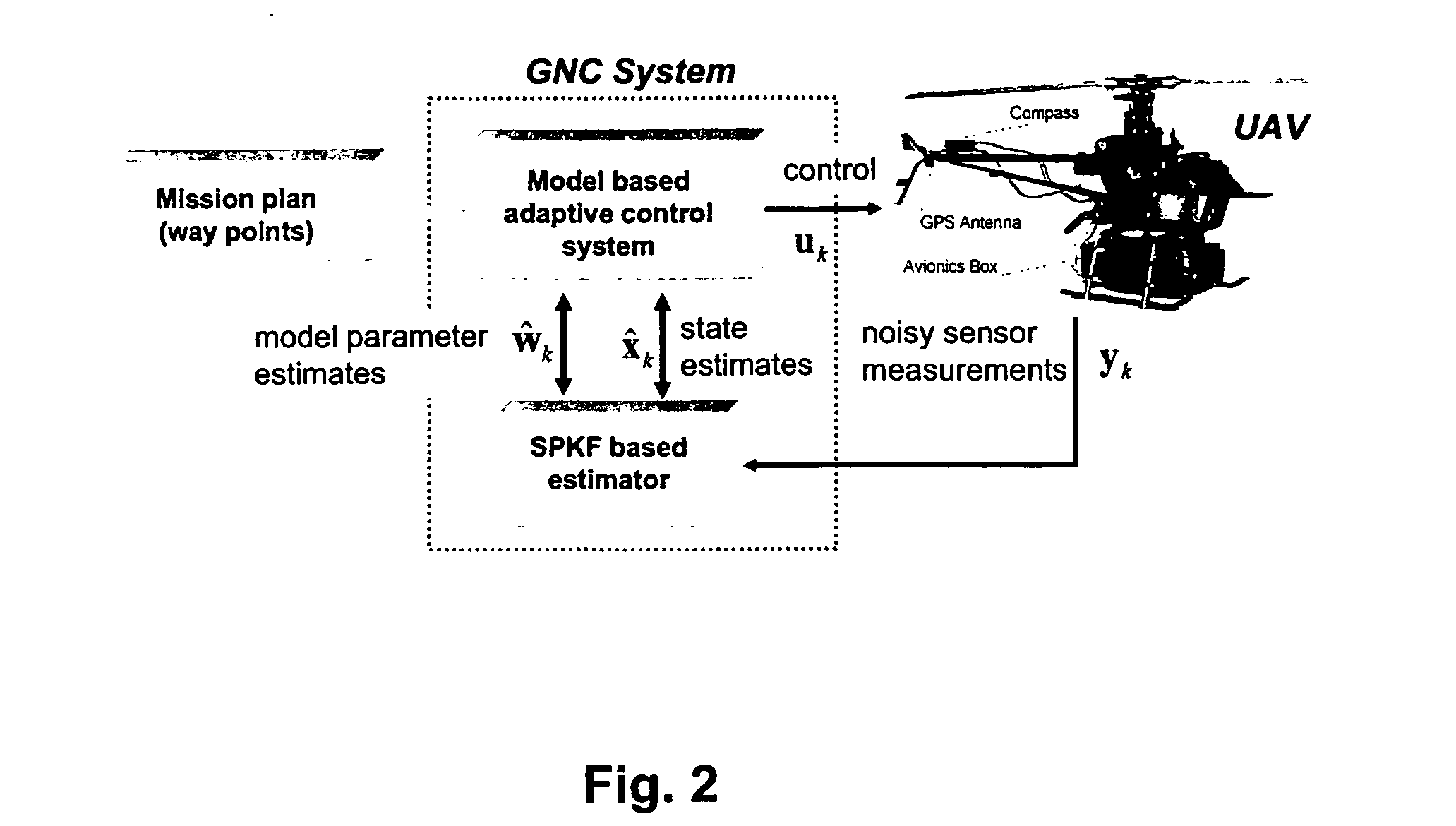Navigation system applications of sigma-point Kalman filters for nonlinear estimation and sensor fusion
a technology of nonlinear estimation and sensor fusion, applied in the field of system estimation, can solve the problems of affecting accuracy, divergence of system, increasing implementation and computational complexity, and unable to use, and achieve the effect of greater estimation accuracy
- Summary
- Abstract
- Description
- Claims
- Application Information
AI Technical Summary
Benefits of technology
Problems solved by technology
Method used
Image
Examples
experiment 1
[0061] In this experiment, the helicopter was flown in simulation along a complex trajectory that increased in “aggressiveness” over time (e.g., rapid-rise-and-hover, figure-eights, and split-s). A graphical rendering of this trajectory is shown in FIG. 5. The SDRE controller used the true known states of the vehicle for the online calculation of the control law, i.e., the SPKF or EKF estimated states were not fed back to the control system. This was done to ensure that the helicopter flew exactly the same flight profile when comparing the estimation performance of the different estimators, and is a main motivation for why the high-fidelity simulation environment is so attractive when comparing different estimation approaches.
Average RMS ErrorpositionvelocityEuler angles (degrees)Algorithm(m)(m / s)rollpitchYawEKF2.10.570.250.322.29SPKF - without LC1.9 (10%)0.52 (9%)0.20 (20%)0.26 (19%)1.03 (55%)SPKF - with LC1.4 (32%)0.38 (34%)0.17 (32%)0.21 (34%)0.80 (65%)
[0062] The table above sum...
experiment 2
[0063] In this experiment “closing the loop” in the GNC system is accomplished by feeding the estimated states back to the SDRE control system. In other words, the vehicle control commands will now be a function of the estimates generated by either the EKF or SPKF estimator and not of the “true” vehicle states. This mimics (in simulation) the true interdependency between the estimation and control system as would occur in the real flight hardware during a fully autonomous flight. This experiment thus not only indicates the difference in estimation performance between the different filters, but also how that translates into improved or worsened control-performance. The average linear quadratic (LQ) control cost (JLQ), which is a function of the difference between the desired and achieved state trajectories, is calculated as a measure of control performance.
[0064] For this experiment, the helicopter was commanded to perform an aggressive high speed nose-in turn. This maneuver require...
experiment 3
[0065] In this experiment, preliminary results in simulation compare the robustness of the SPKF to IMU degradation. FIG. 8 shows RMSE performance versus increase in IMU additive noise (standard scaling of additive white Gaussian noise). Highlighted are the nominal performances of an Inertial Sciences ISIS-IMU (cost>10 k, weight=250 g) and the Cloud Cap Crista IMU (cost<2 k, weight=19 g). The Cloud Cap Crista IMU uses MEMs based gyroscopes and accelerometers manufactured by Analog Devises, and have roughly 40 times as much sensor noise as the ISIS-IMU. As indicated by the curves, the performance of the SPKF with the cheaper and less accurate IMU is still superior to the EKF used with the more expensive IMU.
[0066] Actual flight data experiments: FIG. 9 shows the estimation results of the SPKF compared to the EKF based system on actual test flight telemetry. The UAV was flown under pilot guidance along a complex sweeping S-shaped maneuver until it reached a specified altitude (50 m), ...
PUM
 Login to View More
Login to View More Abstract
Description
Claims
Application Information
 Login to View More
Login to View More - R&D
- Intellectual Property
- Life Sciences
- Materials
- Tech Scout
- Unparalleled Data Quality
- Higher Quality Content
- 60% Fewer Hallucinations
Browse by: Latest US Patents, China's latest patents, Technical Efficacy Thesaurus, Application Domain, Technology Topic, Popular Technical Reports.
© 2025 PatSnap. All rights reserved.Legal|Privacy policy|Modern Slavery Act Transparency Statement|Sitemap|About US| Contact US: help@patsnap.com



